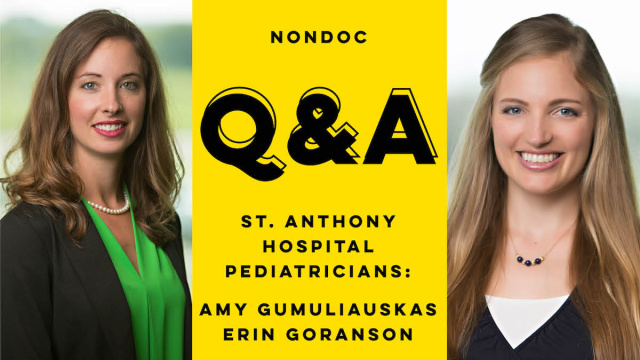
As pediatricians at St. Anthony Hospital, Dr. Erin Goranson and Dr. Amy Gumuliauskas focus on families for a living. It’s a fitting career for both of them: Each endured the illness of a family member earlier in life, which inspired them to pursue careers helping people solve their health problems.
Recently, the pair took the time to answer some questions about familial health, their dream projects and the U.S. health care system as a whole. The following emailed responses have been lightly edited for style.
As pediatricians, what are the most practical solutions you can offer busy parents to help them raise fit kids?
In our crazy-busy lives, simple is always appreciated! During our well-child visits, we usually talk about the “5-2-1-0 rule,” an evidence-based practice designed to improve nutrition and increase activity:
- 5 servings of fruits or vegetables a day
- 2 hours maximum of all screen time
- 1 hour or more of exercise daily
- 0 sugary drinks
There are a number of wonderful resources for parents and kids to learn about how to implement these rules, including OK5210.org, ChooseMyPlate.gov and LetsGo.org.
How would you assess the health literacy of most parents you see? Is it difficult to get some parents (and their children) to comply with doctors’ orders?
Healthy People 2020 defines health literacy as “the degree to which individuals have the capacity to obtain, process, and understand basic health information and services needed to make appropriate health decisions.”
In the state of Oklahoma, health literacy is a common problem. According to the Oklahoma Health Equity Campaign, there are 464,376 people aged 18 or older in the state of Oklahoma without a high school diploma; low literacy and high poverty levels are linked to low health literacy. Poor health literacy results in a greater number of ER visits, hospitalizations and medication errors.
Health literacy is perhaps the most critical part of helping patients. No matter how hard we work to develop an effective plan to manage a child’s illness, if the caregiver does not understand the instructions, it is a moot point. We have to work together with caregivers to identify their learning style in order to ensure understanding before they leave the clinic.
At St. Anthony Healthplex North, we often employ a number of visual aids and hands-on tools, such as an asthma spacer, to show families firsthand how to properly use medication. We know how overwhelming it can be to listen to all the instructions a doctor gives families, so sometimes we have families repeat back instructions to make sure we did a good job of explaining them. We also try to provide reliable resources and ensure questions are answered before families leave.
How much do parents’ health habits affect their children?
Children are sponges. Their growing and developing brains soak in the surrounding environment. They learn about how to function in relationships based on the relationships they see. They repeat what their parents say — parents of toddlers beware!
They also look to parents for reassurance and safety. If children grow up in an environment where parents are exhibiting unhealthy behaviors, those children will likely continue to mimic those behaviors throughout childhood and into adulthood. Obese infants have a 14 percent chance of being obese as an adult, but that chance increases to 75 percent if a child remains obese at 12 years of age. Positive parental role models are imperative in giving children a chance to grow up to be healthy adults.
Childhood obesity rates are still increasing in Oklahoma. What’s the best thing being done right now to combat that, and what are we still not doing that would help the most?
Right now, most Oklahomans are aware that we have a problem with increasing rates of childhood obesity in Oklahoma, and unhealthy behaviors are the source of our problem, but it is difficult to initiate change. Small, gradual changes can make a huge difference in a child’s well-being.
It is often most convenient to start with modifying what the family is drinking. Children need 16 to 24 ounces of low-fat or skim milk per day. Milk should be served at meals, and water in between meals when children are thirsty. Juice, soda, sweetened tea, sports drinks and energy drinks contain large amounts of sugar and extra calories. If a person drinks just one soda per day for one year, they consume 35 pounds of sugar in that year from soda alone. The sugar intake translates into an excess weight gain of 15 pounds per year. If parents refrain from purchasing these unhealthy beverages, then it will be easier for all members of the family to make this change. This is just one example of how simple adjustments made at the grocery store can translate into a healthier future for our children.
Having each gone through similar situations, how do you support the siblings of the sick patients you now treat?
There is no doubt that personal experience creates instant empathy. When a family member is dealing with a medical issue, it affects all members in different ways. When a family is struggling with an illness, we want to ensure families know that as their medical home, we are here to support them, answer questions and coordinate care. We also want to make sure they have an opportunity to discuss their worries and anxieties. Even if we cannot solve a problem, we can listen with compassion and ensure families feel heard.
If you had unlimited funding to study something related to pediatric medicine, what might you choose?
Goranson: Physicians have become much better at identifying children on the autism spectrum; however, we still do not fully understand the cause of autism and have limited treatment options. Although many children on the mild end of the spectrum are high functioning and enjoy fulfilling relationships and living independently, children with more severe symptoms may be nonverbal or have behavioral outbursts that are difficult for children and families alike. Although early intervention services play a pivotal role in maximizing a child’s social and learning skills, we are a far cry from curing this pervasive illness.
In a dreamland of unlimited funds, I would love to invest in determining the cause of this difficult and common illness and determine if there are cures beyond our current treatments.
Gumuliauskas: According to the Centers for Disease Control, “Respiratory syncytial virus (RSV) is the most common cause of lower respiratory tract infections among young children in the United States and worldwide.” Despite its commonality, many people are unaware that in an average year in the United States this virus, which affects both children and adults, results in the following:
- 57,527 hospitalizations among children younger than 5 years old
- 1 million outpatient visits among children younger than 5 years old
- 177,000 hospitalizations and 14,000 deaths among adults older than 65 years
There is currently no cure for RSV. Although there is a prophylactic treatment, it is extremely cost prohibitive and currently only available to children with special health needs (extreme prematurity, weakened immune system, chronic lung or heart disease).
A vaccine against RSV would be an enormous contribution to children worldwide. Although there are researchers working on vaccines, an unlimited pool of money would certainly expedite the process.
If you could change one thing about the U.S. health care system, what would it be?
We agree that one of best parts of being a pediatrician is the opportunity to educate families about making safe and healthy lifestyle choices through anticipatory guidance. We wish the U.S. health care system focused more on prevention rather than intervention. For example, imagine if a child could be taught to live an active lifestyle and make nutritious food choices early on. Learning to make good choices early can lead to a lifetime of healthier habits. Maintaining a body mass index (BMI) in less than 85th% decreases the risk for diabetes type 2, heart disease, high blood pressure, etc. Diabetes type 2 can lead to other severe problems, such as heart failure, poor circulation, blindness, and kidney disease. Imagine the physical and emotional “savings” for the individual in addition to the monetary savings for both the individual and society if the disease could be prevented in the first place. As today’s children are our future leaders, an emphasis on prevention is key to creating a healthy country.
What do you like most about St. Anthony’s Hospital? What’s your favorite thing in the cafeteria?
St. Anthony has been hard at work remodeling the cafeteria. We are looking forward to the end result. When we are on campus, we typically love to eat the sushi, which is made fresh.





















